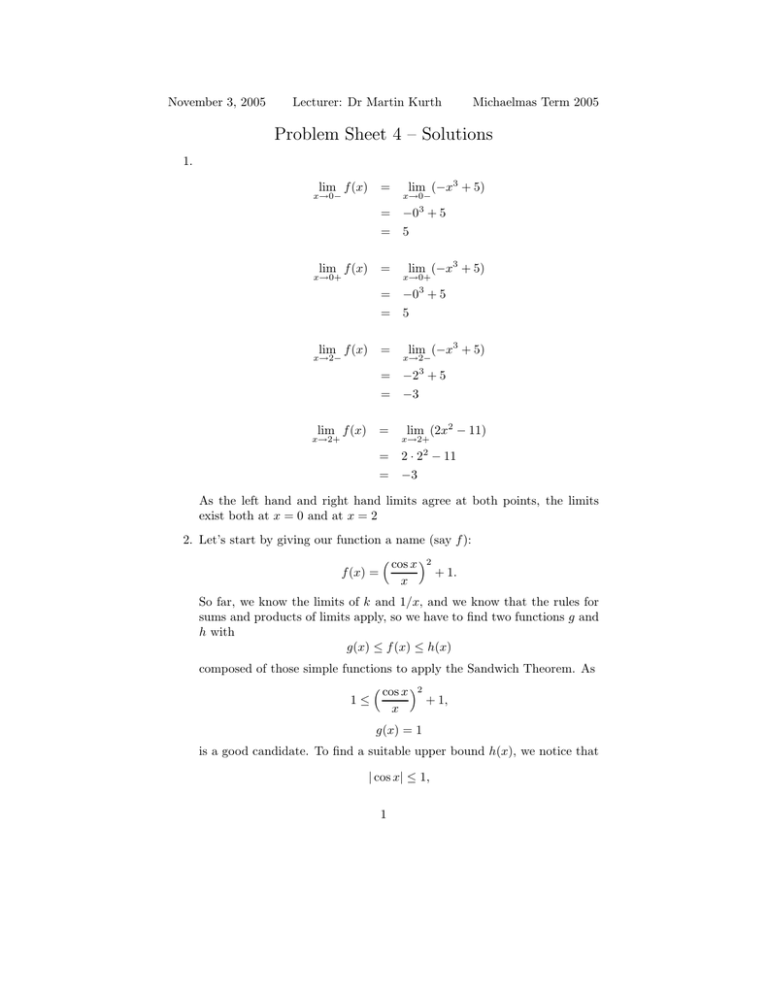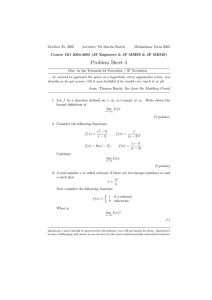Problem Sheet 4 – Solutions
advertisement

November 3, 2005 Lecturer: Dr Martin Kurth Michaelmas Term 2005 Problem Sheet 4 – Solutions 1. lim f (x) x→0− = lim (−x3 + 5) x→0− 3 = −0 + 5 = 5 lim f (x) x→0+ = lim (−x3 + 5) x→0+ 3 = −0 + 5 = 5 lim f (x) x→2− = lim (−x3 + 5) x→2− 3 = −2 + 5 = −3 lim f (x) = x→2+ lim (2x2 − 11) x→2+ 2 = 2 · 2 − 11 = −3 As the left hand and right hand limits agree at both points, the limits exist both at x = 0 and at x = 2 2. Let’s start by giving our function a name (say f ): cos x 2 f (x) = + 1. x So far, we know the limits of k and 1/x, and we know that the rules for sums and products of limits apply, so we have to find two functions g and h with g(x) ≤ f (x) ≤ h(x) composed of those simple functions to apply the Sandwich Theorem. As cos x 2 1≤ + 1, x g(x) = 1 is a good candidate. To find a suitable upper bound h(x), we notice that | cos x| ≤ 1, 1 and thus cos2 x ≤ 1. This means that cos x 2 1 + 1 ≤ 2 + 1, x x and we can choose this as our h(x). Now we can calculate the limits of g and h: lim g(x) = lim 1 = 1, x→∞ x→∞ 1 lim h(x) = lim + 1 = 1. x→∞ x→∞ x2 Thus we have lim g(x) = lim h(x) = 1, x→∞ x→∞ and by the Sandwich Theorem lim f (x) = 1. x→∞ 3. The first thing to notice here is that lim θ→π/4+ cos2 (θ − π/4) = lim cos2 (θ), θ→0+ and we introduce the notation f (θ) = cos2 (θ). Again, we only know limits of k and θ, and have to find functions g and h with g(θ) ≤ f (θ) ≤ h(θ), that are combinations of such simple functions. As we are looking at the right-hand limit at 0, we can restrict ourselves to 0<θ< π , 2 and study the situation in this picture: r y θ x 2 s Now we have cos2 (θ) = x2 r2 and x2 = r 2 − y 2 (from Pythagoras’ Theorem), such that cos2 (θ) = 1 − y2 . r2 Furthermore, we know from our picture that y≤s and thus y 2 ≤ s2 , which gives us cos2 (θ) ≥ 1 − As the angle θ is defined as s2 . r2 s θ= , r we have cos2 (θ) ≥ 1 − θ2 . This gives us a candidate for our function g: g(θ) = 1 − θ 2 . As we know that cos2 (θ) ≤ 1, we choose h(θ) = 1. Now we have g(θ) ≤ f (θ) ≤ h(θ), and lim g(θ) = lim (1 − θ2 ) = 1, θ→0+ θ→0+ lim h(θ) = lim 1 = 1, θ→0+ θ→0+ and thus lim f (θ) = 1. θ→0+ 3






